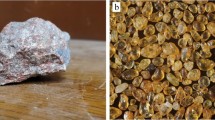Summary
Demagging processes can be divided into three general categories: 1) chlorination processes, in which chlorine gas is bubbled into the molten aluminum to react preferentially with magnesium which is finally removed as magnesium chloride dross; 2) solid flux processes, in which a solid-flux (AlCl3, AlF3), is mixed into the molten aluminum to react with magnesium which is again removed as chloride or fluoride dross; and 3) electrochemical processes, in which magnesium is removed as metal on the cathode by passing a current between the molten aluminum anode covered with an electrolyte and an inert cathode dipped into the electrolyte. Of the processes reviewed, chlorination methods are the most widely practiced in the industry and seem reasonably efficient. However, most of the chlorination processes appear to have emission and waste generation (MgCl2 dross) problems. The electrochemical processes have been tested only on laboratory scale so far, but they look promising for commercial use. If successfully developed, the electrochemical processes would be pollution-free, and magnesium metal would be recovered as a by-product.
Similar content being viewed by others
References
W.E. Martin, Trans. Am. Foundrymen’s Soc, 50 (1942), pp. 766–784.
M.C. Mangalick, Light Metals, The Metallurgical Society of AIME, 2, (1974), pp. 613–634.
Private Communication, R. Johnson, GM Central Foundry, Bedford, October 1980.
R.E. Miller, L.C. Blayden and M.J. Bruno, Light Metals 1978, The Metallurgical Society of AIME, (197&), pp. 491–505.
CA. Licht, Light Metals 1977, The Metallurgical Society of AIME, (1977), pp. 279–290.
L.J. Derham and M.G. Derham, “Purification of Aluminum,” U.S. Patent No. 3650730, March 1972.
L. Smith, J. Metals, 30(9), (1978), pp. 15–19.
J.E. Dore, J.C. Yarwood and J.A. Ford, Light Metals 1976, The Metallurgical Society of AIME, (1976), pp. 567–583.
J.J. Moor, International Metals Reviews, No. 5, (1978), pp. 241–264.
P.D. Hess, “Magnesium Removal from Aluminum Alloy Scrap,” U.S. Patent No. 3620716, November 1971.
M.V. Rao, “Removal of Magnesium from an Aluminum Alloy,” U.S. Patent No. 4097270, June 1978.
E.E. Lukashenko and A.M. Pogodayev, Russian Metallurgy (Metally), No. 5, (1971), pp. 69–72.
A.I. Belyaev, A. Ya. Fisher and A.G. Nikitin, Tsvetn. Metal., 39(4), (1966), pp. 84–86.
A.G. Nikitin, A.I. Belyaev, and A. Ya. Fisher, Tsvetn. Metal., 11(4), (1968), pp. 62–64.
J.H. Cleland and D.J. Fray, Advances in Extractive Metallurgy, The Institute of Mining and Metallurgy, London, (1977), pp. 141–146.
Y. Tsumura, “Demagging Process for Aluminum Alloy without Air Pollution,” U.S. Patent No. 4183745, January 1980.
H. Burkhardt, “Process for Purifying and Transporting Light Metal,” U.S. Patent No. 3335076, August 1967.
JANAF Thermochemical Tables, Second Edition, NSRDS-NBS-37, June 1971.
Author information
Authors and Affiliations
Additional information
Dr. Tiwari received his BS in metallurgical engineering from Banaras Hindu University, India, in 1970 and MS and Eng ScD in chemical metallurgy from Columbia University in 1973 and 1976. From 1976–1978, Dr. Tiwari worked for Martin Marietta Laboratories. He is presently with General Motors Research Laboratories. Dr. Tiwari is a member of the Metallurgical Society of AIME.
Rights and permissions
About this article
Cite this article
Tiwari, B.L. Demagging Processes for Aluminum Alloy Scrap. JOM 34, 54–58 (1982). https://doi.org/10.1007/BF03338052
Published:
Issue Date:
DOI: https://doi.org/10.1007/BF03338052




